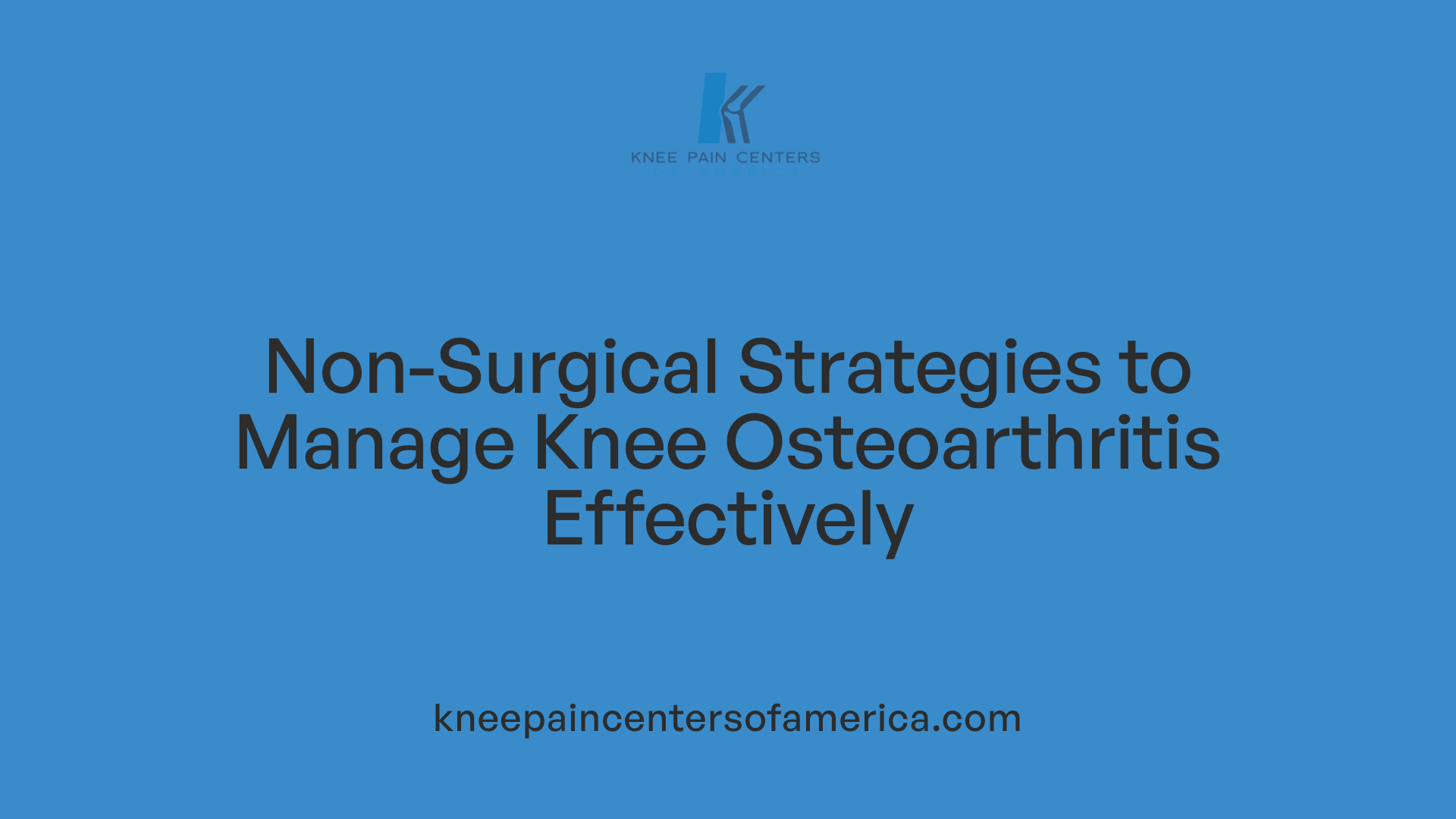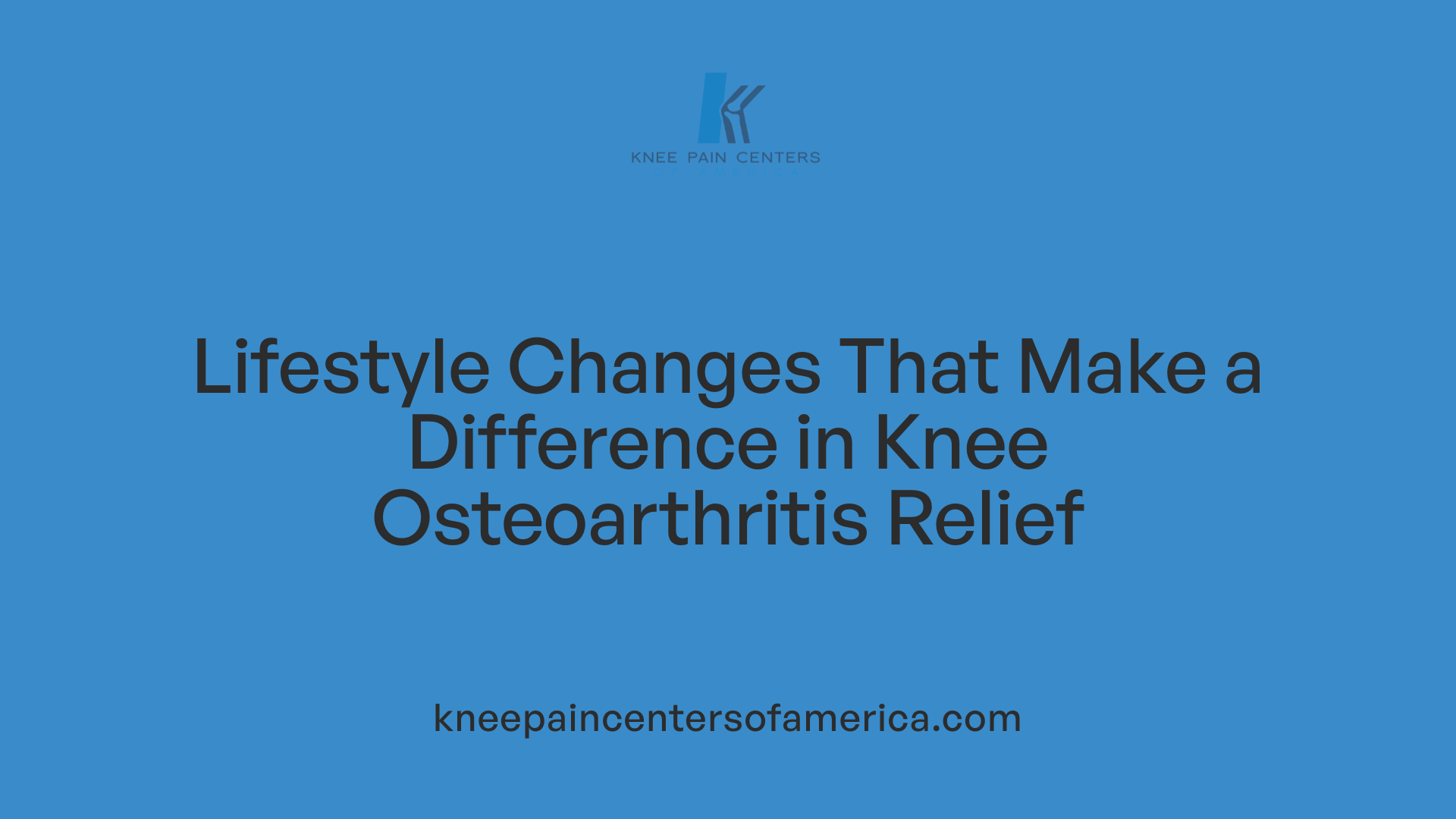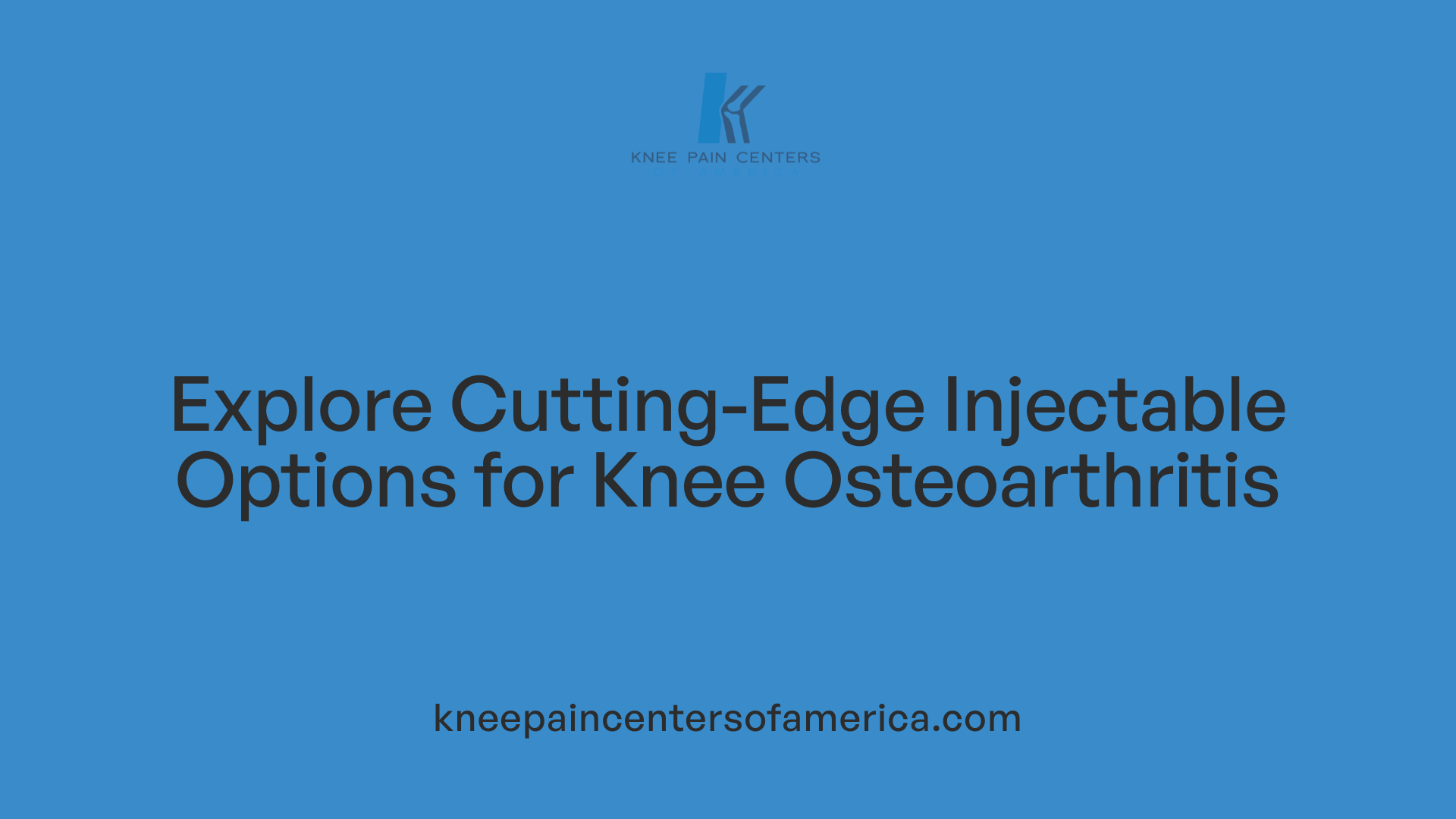Understanding Knee Osteoarthritis and Its Impact
Knee osteoarthritis is a prevalent joint condition causing pain, stiffness, and reduced mobility, primarily affecting adults over the age of 45. As cartilage deteriorates, patients often experience symptoms that can severely impact quality of life. This article addresses common questions about non-surgical knee care, providing an in-depth look at treatment options, lifestyle modifications, and emerging therapies aimed at managing symptoms while delaying or avoiding surgery.
Common Medical Treatments for Knee Pain and Osteoarthritis

What are common medical treatments for knee pain and osteoarthritis?
Managing knee osteoarthritis and related pain involves a variety of medical treatments tailored to relieve symptoms, improve mobility, and enhance quality of life.
Medications for Pain Relief
Over-the-counter options such as acetaminophen and nonsteroidal anti-inflammatory drugs (NSAIDs) are widely used to reduce pain and inflammation. Topical creams containing agents like capsaicin can provide localized relief. In some severe cases, opioids may be prescribed but with caution due to potential side effects.
Physical Therapy
Physical therapy plays a crucial role in treatment by strengthening muscles supporting the knee, improving joint flexibility, and reducing pain. Exercises often include stretching, low-impact cardio, and light weight training. Home-based programs are as effective as supervised sessions and help maintain joint function.
Injections
Intra-articular corticosteroid injections reduce inflammation and provide short-term pain relief. Hyaluronic acid injections aim to lubricate the joint, facilitating smoother movement and alleviating discomfort. These are generally used when other treatments do not suffice.
Surgical Options Overview
Surgery is considered when conservative treatments fail to control symptoms. Procedures range from arthroscopic repair and osteotomy to partial or total knee replacement. Cartilage restoration techniques may be suitable for younger patients with minimal damage.
Complementary Therapies and Lifestyle Modifications
Complementary therapies like acupuncture can assist with pain management, although more research is needed. Lifestyle changes, including weight management and low-impact exercise, significantly reduce mechanical stress on the knee and improve function. Supportive devices like knee braces also aid in stabilizing the joint and reducing pain.
Together, these treatments form a comprehensive approach to managing knee osteoarthritis, aiming to delay or avoid the need for surgery while enhancing comfort and mobility.
Role and Benefits of Non-Surgical Therapies in Osteoarthritis Management

How do non-surgical therapies help in managing osteoarthritis of the knee?
Non-surgical therapies for knee osteoarthritis target pain relief and improved joint function through multiple strategies.
Weight Management Impact
Maintaining a healthy body weight significantly reduces mechanical stress on the knee joints. This decreases cartilage degeneration and slows the progression of osteoarthritis, especially in overweight or obese patients. Losing just a few pounds can lead to noticeable symptom improvement.
Strengthening Exercises
Physical therapy focuses on strengthening muscles around the knee—such as the quadriceps and hamstrings—which act as natural shock absorbers and stabilize the joint. Exercise programs often include stretching and low-impact cardio, which boost flexibility and maintain joint health. Both supervised and home-based regimens are effective.
Assistive Devices
Using knee braces, supports, or walking aids helps offload pressure from damaged parts of the joint. Bracing complements physical therapy but should not replace active rehabilitation. These devices can improve mobility and reduce pain during daily activities.
Pharmacological Options
Medications like over-the-counter NSAIDs and acetaminophen reduce inflammation and provide short-term pain relief. Corticosteroid injections offer more potent but temporary reduction in swelling and pain. Hyaluronic acid injections aim to improve joint lubrication and movement, although benefits vary. Turmeric supplements and newer weight-loss drugs like semaglutide have shown promise in symptom alleviation.
Patient Education and Self-Management
Empowering patients with information about their condition encourages adherence to treatment plans. Self-management strategies include activity modification, regular exercise, weight control, and proper use of medications and assistive devices. Collaboration between patients and healthcare providers ensures individualized, effective care.
| Therapy Component |
Purpose |
Benefits |
| Weight Management |
Reduce joint load |
Slows cartilage damage; decreases pain |
| Strengthening Exercises |
Build muscle support around knee |
Stabilizes joint; enhances function |
| Assistive Devices |
Offload pressure; support mobility |
Reduces pain; improves stability |
| Pharmacological Treatments |
Inflammation control and symptom relief |
Short-term pain reduction; improved mobility |
| Patient Education |
Promote active self-care and adherence |
Better outcomes; delays progression |
Impact of Lifestyle Modifications on Knee Osteoarthritis Symptoms

What role does lifestyle modification play in managing knee osteoarthritis symptoms?
Lifestyle modifications significantly help in managing knee osteoarthritis by reducing joint stress and enhancing joint health. One major factor is weight management. Excess weight increases pressure on knee joints, accelerating cartilage wear and worsening symptoms. Losing even a small amount of weight can considerably decrease pain and improve mobility.
Weight loss importance
Reducing body weight eases mechanical load on the knees, leading to less pain and slower disease progression. It is strongly recommended as part of knee osteoarthritis management, especially for overweight and obese patients.
Exercise recommendations
Regular, low-impact physical activity is key. At least 150 minutes per week of exercises like walking, swimming, or cycling helps strengthen muscles supporting the knee and improves joint function. Physical therapy focusing on stretching and strengthening exercises complements these efforts and reduces stiffness and pain.
Diet and supplements
Eating a balanced diet rich in fruits, vegetables, and omega-3 fatty acids promotes overall joint health. Some supplements such as turmeric (1000 mg daily), vitamin D, and glucosamine may offer symptom relief, though evidence varies. Over-the-counter NSAIDs can aid short-term pain and inflammation management.
Patient education
Educating patients on lifestyle changes, proper medication use, and joint protection strategies is essential. Encouraging activity modification instead of inactivity helps prevent further joint deterioration and supports a better quality of life. Understanding available treatment options empowers individuals to actively participate in their care plan.
Advancements in Injectable Treatments for Knee Osteoarthritis

What are the latest advancements in injectable treatments for knee osteoarthritis?
Injectable treatments for knee osteoarthritis have evolved beyond traditional options such as corticosteroid and hyaluronic acid injections. Recent developments focus on enhancing knee function and delaying surgery through biologic therapies.
Corticosteroid injections continue to provide quick and effective anti-inflammatory relief. They are useful for reducing swelling and pain shortly after administration but are recommended sparingly, typically limited to a few injections per year, due to risks of tissue damage with overuse.
Hyaluronic acid injections, often derived from gel formulations like Gel-One, act by lubricating the joint to reduce friction between bones. These injections can provide pain relief lasting up to six months and have fewer side effects compared to corticosteroids. However, their overall benefit remains debated, with some guidelines suggesting reserving them for cases where other treatments have failed.
Emerging biologic therapies, including platelet-rich plasma (PRP) and stem cell injections, aim to harness the body's healing mechanisms. PRP involves concentrating a patient’s own platelets to deliver growth factors that may reduce inflammation and stimulate cartilage repair. Stem cell therapies use cells capable of tissue regeneration, targeting disease-modifying effects. Though promising, these treatments are still considered experimental, lack FDA approval specifically for osteoarthritis, and require further clinical research to validate their long-term safety and efficacy.
Together, these injectable options offer a spectrum of minimally invasive treatments for knee osteoarthritis. They provide different mechanisms to alleviate pain and improve joint function while reducing the necessity for knee replacement surgery. Ongoing studies strive to optimize protocols and identify which patients will benefit most from each approach.
| Injectable Treatment |
Mechanism of Action |
Duration of Effect |
Safety Considerations |
| Corticosteroid Injections |
Anti-inflammatory, reduces swelling |
Weeks to months |
Limited frequency due to risk of tissue damage |
| Hyaluronic Acid Injections |
Lubricates joint, reduces friction |
Up to 6 months |
Generally safe, benefits vary among patients |
| Platelet-Rich Plasma (PRP) |
Promotes healing and reduces inflammation |
Variable; under study |
Experimental; not FDA-approved for knee OA |
| Stem Cell Therapy |
Regenerative potential for cartilage repair |
Experimental |
Under investigation; safety and efficacy not established |
When Is Surgical Intervention Recommended for Knee Osteoarthritis?

When is surgical intervention recommended for knee osteoarthritis?
Surgical intervention for knee osteoarthritis is generally considered when non-surgical treatments have failed to sufficiently relieve pain and improve knee function. Key indications include persistent and severe pain that impacts daily activities, such as difficulty walking more than three blocks or inability to sleep due to discomfort. Additionally, surgery may be recommended for joint instability, deformities of the limb, loose prosthetic components from previous surgeries, or fractures that do not respond to conservative care.
Before surgery is considered, patients typically undergo a comprehensive period of conservative management. This often includes six months or more of nonsteroidal anti-inflammatory drugs (NSAIDs), physical therapy focused on strengthening the muscles around the knee, weight management, and sometimes corticosteroid or viscosupplementation injections.
What are the criteria for joint replacement?
Criteria for knee joint replacement include advanced joint damage often described as "bone-on-bone" arthritis where cartilage is no longer present, significant pain at rest or during movement, decreased range of motion, and functional limitations that severely affect quality of life. Surgery aims to restore mobility, relieve pain, and improve overall joint stability.
What types of surgical procedures are available?
There are several surgical options depending on the extent and location of the osteoarthritis:
- Total Knee Replacement (TKR): Suitable for severe, widespread joint damage; involves replacing the entire knee joint.
- Partial Knee Replacement: Used when arthritis is localized to one compartment of the knee.
- Cartilage Restoration Procedures (Grafting): Appropriate for younger patients with minimal joint damage.
- Osteotomy: Involves cutting and realigning the bone to shift weight away from the damaged area, ideal for younger patients with arthritis on one side.
- Arthroscopy: Minimally invasive procedure used to repair cartilage or remove loose fragments, though its role is limited in advanced osteoarthritis.
How is pre-surgical non-surgical management approached?
Before surgery, patients are encouraged to maximize conservative treatments, including:
- Physical therapy exercises to strengthen support muscles and improve joint function.
- Use of pain-relieving medications such as NSAIDs and acetaminophen.
- Corticosteroid injections to reduce inflammation.
- Weight loss to reduce joint load.
- Assistive devices like braces to provide joint stability.
This pre-surgical management helps optimize outcomes and may also postpone or reduce the need for surgical intervention.
Integrating Non-Surgical Options for Optimal Knee Care
Managing knee osteoarthritis effectively often relies on a comprehensive approach encompassing medications, physical therapies, lifestyle adjustments, and innovative minimally invasive procedures. Non-surgical treatments can significantly reduce pain, improve joint function, and delay the need for surgery, enhancing patient quality of life. For many individuals, collaborating with healthcare providers to tailor a personalized care plan ensures symptom control and functional improvement while preserving mobility. As medical science advances, emerging therapies promise even greater options for those seeking relief without surgery, emphasizing the importance of informed decision-making and proactive management.
References